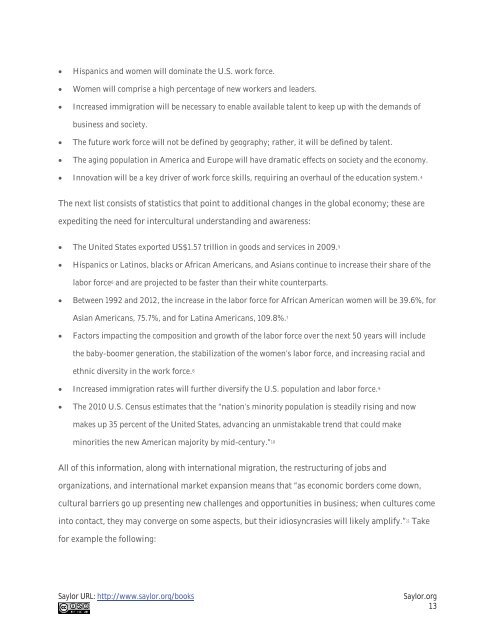Leading with Cultural Intelligence, 2012a
Leading with Cultural Intelligence, 2012a
Leading with Cultural Intelligence, 2012a
You also want an ePaper? Increase the reach of your titles
YUMPU automatically turns print PDFs into web optimized ePapers that Google loves.
Hispanics and women will dominate the U.S. work force.<br />
Women will comprise a high percentage of new workers and leaders.<br />
Increased immigration will be necessary to enable available talent to keep up <strong>with</strong> the demands of<br />
business and society.<br />
<br />
<br />
The future work force will not be defined by geography; rather, it will be defined by talent.<br />
The aging population in America and Europe will have dramatic effects on society and the economy.<br />
Innovation will be a key driver of work force skills, requiring an overhaul of the education system. 4<br />
The next list consists of statistics that point to additional changes in the global economy; these are<br />
expediting the need for intercultural understanding and awareness:<br />
The United States exported US$1.57 trillion in goods and services in 2009. 5<br />
<br />
Hispanics or Latinos, blacks or African Americans, and Asians continue to increase their share of the<br />
labor force 6 and are projected to be faster than their white counterparts.<br />
<br />
Between 1992 and 2012, the increase in the labor force for African American women will be 39.6%, for<br />
Asian Americans, 75.7%, and for Latina Americans, 109.8%. 7<br />
<br />
Factors impacting the composition and growth of the labor force over the next 50 years will include<br />
the baby-boomer generation, the stabilization of the women’s labor force, and increasing racial and<br />
ethnic diversity in the work force. 8<br />
Increased immigration rates will further diversify the U.S. population and labor force. 9<br />
<br />
The 2010 U.S. Census estimates that the “nation’s minority population is steadily rising and now<br />
makes up 35 percent of the United States, advancing an unmistakable trend that could make<br />
minorities the new American majority by mid-century.” 10<br />
All of this information, along <strong>with</strong> international migration, the restructuring of jobs and<br />
organizations, and international market expansion means that “as economic borders come down,<br />
cultural barriers go up presenting new challenges and opportunities in business; when cultures come<br />
into contact, they may converge on some aspects, but their idiosyncrasies will likely amplify.” 11 Take<br />
for example the following:<br />
Saylor URL: http://www.saylor.org/books<br />
Saylor.org<br />
13


















